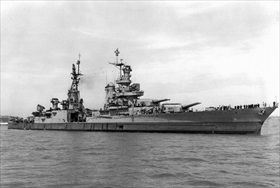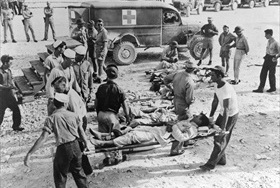USS INDIANAPOLIS LEAVES IN MYSTERY CLOAK
San Francisco, California · July 15, 1945
On this date in 1945 the USS Indianapolis, a Portland-class cruiser in California for repairs, received orders to pick up a piece of special cargo at Hunters Point (predecessor name for the now-closed San Francisco Naval Yard). Eleven days later, on July 26, the Indianapolis delivered her mysterious cargo to the B‑29 base on the Central Pacific island of Tinian in the Marianas. Four days later Japanese submarine I‑58 sank the Indianapolis as the warship was en route to Leyte in the Philippines, inflicting the greatest loss of life in U.S. naval history: 300 sailors were killed in the torpedo attack, and the remaining 800 bobbed in the unforgiving sun and shark-infested waters of the Pacific for four days without the U.S. Navy being aware they were missing. When at last they were spotted by accident and rescued, just 316 out of the original 1,196 crew had survived the sinking, exposure, dehydration, and shark attacks.
(A scapegoat Naval court-martial in November 1945 would declare the Indianapolis’ skipper, Captain Charles McVay III, culpable for the loss of his ship, although the Indianapolis had neither escort vessel [requested but rejected] nor sonar gear, which conceivably could have altered events. Fleet Admiral Chester Nimitz remitted McVay’s sentence. McVay committed suicide in 1968.)
Of course the Indianapolis’ mysterious cargo consisted of the key fissile components for “Little Boy,” the codename for the atomic bomb dropped on Hiroshima on August 6, 1945. Developed by the Manhattan Project headed by J. Robert Oppenheimer at a cost of nearly $2 billion, “Little Boy” derived its explosive power (equivalent to 15,000 tons of TNT) from the nuclear fission of less than 35 ounces of uranium‑235. The Hiroshima bombing was the second nuclear explosion in history, after the Trinity test near Alamagordo, New Mexico, and the first uranium-based detonation. (The Trinity test occurred one day after the Indianapolis left port for Tinian.) “Little Boy” killed perhaps 70,000 people outright. With the detonation of the more powerful plutonium‑239‑based “Fat Man” over Nagasaki three days later, which added 40,000 more deaths to the tally of the dead (to say nothing of the forever-maimed, the chronically ill, and the recovered wounded), nuclear weapons and their peaceful offspring exerted a profound impact on the rest of the twentieth century and into the present.
![]()
USS Indianapolis, July 1945
 |  |
Left: USS Indianapolis off California’s Mare Island, July 10, 1945, days after the heavy cruiser’s final overhaul and repair of combat damage (incurred on March 31, 1945) and five days before setting off for the Central Pacific island of Tinian to deliver critical elements of the atomic bomb that was dropped on Hiroshima, Japan. The Indianapolis served as flagship for Admiral Raymond Spruance while he commanded the U.S. Fifth Fleet in its battles across the Central Pacific.
![]()
Right: USS Indianapolis’ survivors on Guam, August 1945. Torpedoed by Japanese submarine I‑58 on July 30, 1945, the Indianapolis rolled completely over and sank, bow first, within 12 minutes of being hit. About 800 of the 1,196 crewmen aboard initially survived the fiery sinking, although the ship’s lifeboats—that is, those that cleared the vessel—could accommodate few of them. Many of the men treaded water without life vests. By the time the survivors were rescued four days and five nights after their warship went down, only 321 remained; four soon died. Most of the deaths on the Indianapolis were due to exposure, saltwater poisoning, and thirst, with the dead being dragged off by sharks.
Mission of Misfortune: The USS Indianapolis
![]()

 History buffs, there is good news! The Daily Chronicles of World War II is now available as an ebook for $4.99 on Amazon.com. Containing a year’s worth of dated entries from this website, the ebook brings the story of this tumultuous era to life in a compelling, authoritative, and succinct manner. Featuring inventive navigation aids, the ebook enables readers to instantly move forward or backward by month and date to different dated entries. Simple and elegant! Click
History buffs, there is good news! The Daily Chronicles of World War II is now available as an ebook for $4.99 on Amazon.com. Containing a year’s worth of dated entries from this website, the ebook brings the story of this tumultuous era to life in a compelling, authoritative, and succinct manner. Featuring inventive navigation aids, the ebook enables readers to instantly move forward or backward by month and date to different dated entries. Simple and elegant! Click 











